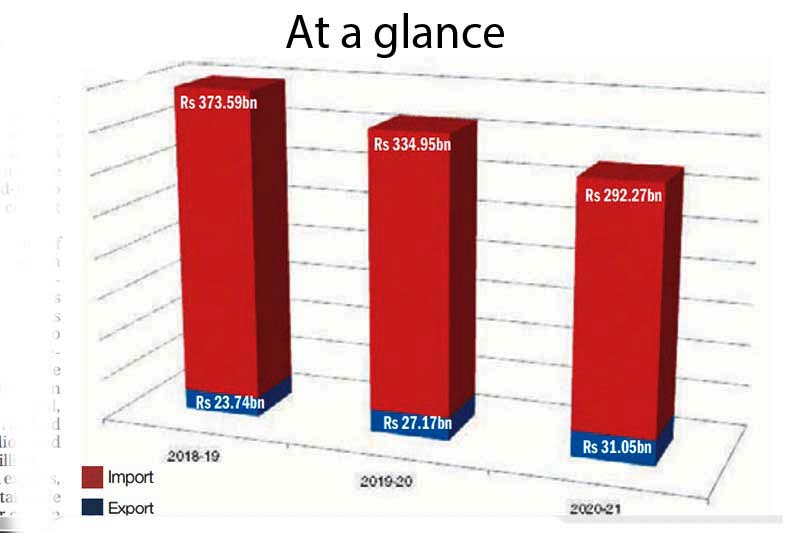Nepal’s trade deficit down 15.1 per cent in Q1
KATHMANDU, NOVEMBER 4
The coronavirus pandemic has, among other disruptions, also affected Nepal’s trade balance, reducing the country’s deficit by 15.1 per cent in the first three months (mid-July to mid-October) of the current fiscal year.
As per the trade statistics of Trade and Export Promotion Centre, Nepal’s exports increased by 14.3 per cent to Rs 31.05 billion whereas imports decreased by 12.7 per cent to Rs 292.27 billion during the review period, causing a trade deficit of Rs 261.22 billion. In the same period of last fiscal, the country’s exports had stood at Rs 24.17 billion and imports at Rs 334.95 billion.
With the increase in exports, its contribution in total trade also rose from 7.5 per cent in the first three months of previous fiscal to 9.6 per cent in the corresponding period of current fiscal.
The export-import ratio, which had stood at 1:12.3 in first three months of previous fiscal dropped to 1:9.4 during the review period.
As per the TEPC report, soyabean oil was the top export commodity in the first quarter with 24.5 per cent share of total exports. The country exported soyabean oil worth Rs 7.6 billion, 414 per cent up compared to the corresponding period of last fiscal.
Similarly, the exports of tea increased by 150.1 per cent to Rs 2.18 billion, essential oils by 237.5 per cent to Rs 281 million and noodles and pasta by 84.5 per cent to Rs 590 million.
According to Deepak Khanal, spokesperson for National Tea and Coffee Development Board, the surge in export of tea can be attributed to increase in its price and high international demand. “Setting up an internationally accredited lab in the country, promoting organic farming and effective marketing would go a long way in boosting our agricultural export,” he opined.
In contrast, the exports of readymade garments fell by 10.8 per cent to Rs 1.75 billion, lentils by 67.6 per cent to Rs 131 million and palm oil by 100 per cent to Rs 443,000.
Goods of small and medium-sized enterprises covered 38.6 per cent, agro-based products covered 35.1 per cent and agro products covered 16.2 per cent shares in total exports, as per TEPC.
On the other hand, iron and steel products, petroleum products, machinery and parts, transport vehicles and parts and cereals were top five goods imported during the first three months of current fiscal. The country imported iron and steel products worth Rs 28.1 billion (down 17.9 per cent), petroleum products worth Rs 23.17 billion (down 45 per cent), machinery and parts worth Rs 22.8 billion (down 18.8 per cent ) and transport vehicles and parts worth Rs 19.83 billion (down 27.5 per cent) in the review period.
Cereals imports, meanwhile, stood at Rs 19.75 billion, a surge of 113.5 per cent compared to previous fiscal.
Gold import surged by an eye-popping 1116.6 per cent to Rs 737 million, whereas the import of crude soyabean oil surged by 104 per cent to Rs 8.14 billion in the review period.
Attributing the drop in import of previous top commodities such as petroleum products and vehicles to the pandemic and lockdown, economist Achyut Wagle said, “What is more worrisome is that the import of agricultural products and consumer items — which could be substituted with domestic production — has not reduced.”
Economist Bishal K Chalise also said the drop in the trade deficit was just a temporary phenomenon created by the pandemic and lockdown. Stating that the foundation of Nepal’s export is small in size and weak, he claimed that the export items should have scalability in terms of production to strengthen the country’s export base.






